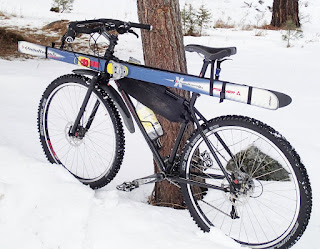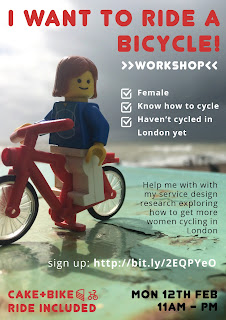What's the difference between a bicycle and a pair of skis?
 |
| image credit: andrusc |
Ten years ago I worked in a ski school in the French Alps, taking bookings and helping with children's lessons. It was a great lifestyle - although I still had an office job for the most part, nearly every day I would be out on the mountain for a few hours, and if I was going to see a friend in another part of the resort it would normally neccessitate skiing to get there. Days off were spent out on the mountain with friends, stopping off for a picnic, hot chocolate or vin chaud.
If you've been lucky enough to get to grips with skiing, you'll no doubt appreciate the wonderful feeling of gliding down the mountain, cutting through the snow or floating over fresh powder off piste. Although a little more challenging to master, once accomplished, skiing it not disimilar to the magical, liberating feeling of riding a bicycle.
Now scale this up to a whole village or small town of people indulging in this simple pleasure nearly everyday, simultaneously imursed in nature - in the mountains - and also getting a bit of physical, socialable excercise. Even for those don't enjoy skiing or physically can't take it anymore, there are still options to walk or take the cable car to the top of the mountain and enjoy the view. All this makes for a pretty nice place to live for a few months. I count myself lucky to have spent two winter seasons living in this way.
 |
| The view from my kitchen window, Feb 2010 |
Now in the thick of London life and emursed in the final intense weeks of my masters degree, I'm seeing the unlikely parallels between mountain life and city life. Unbeknown to my younger self, my seasonnaire experience was a premature piece of analogous research for this project. Before I eleaborate let's first understand the current thinking around where life in cities is heading.
Cities 2.0 according to the media
If you've been listening to the news at all for the past year, you'll have been made aware that we are on the brink of an electric vehicle revolution. Forget hybrid - Prius is so last season darling - all of the established motor brands are eager to follow in the wake of Tesla with their own iterations of smart electric cars, and governments are proud to annouce their investments in electric vehicle charging infrastructure too - the UK government annouced a £500 million investment in its 2017 November budget.The consequent concens of adopting electric vehicles (EVs) focuses largely on the urgent need for new charging infrastructure and the potential peak demand of electricity, as everyone arrives home from work to charge their car at the same time. Some debate is given to the fact that EVs still contibute to air pollution just with a longer tail-pipe, but this is often regarded as more of a distraction from the localised benefits of reducing air pollution in cities where its currently a hot topic. Surprisingly - to me at least - the media seem to ignore the fact that everyone simply ditching their diesel (or petrol) car for an electric version does nothing to address the very real and costly problems of congestion and urban population growth, inactivity and obesity, mental health or emotional wellbeing.
Nevermind that though, by the time we have the main concerns ironed out - charging infrastructure, electricty supply, renewable energy - we'll be all geared up to go fully autonomous, embracing the most efficient transport system imaginable. All of the planet's foremost tech and mobility companies have our backs on this, with partnerships and takeovers involving everyone from Google, Apple and Uber, to numerous smaller startups pioneering AI technologies that will allow us to completely disengage form the functions of navigation and movement save using our thumbs to manipulate the screens of our smart devices - or to enjoy a freshly delivered Domino's Pizza.
This is the future city of science fiction movies coming to a screen near you very soon. At least that's what they want you to believe. Writing in a recent blog post reporting back from discussions around the future of urban mobility at SXSW 2018, Jeff Risom of Gehl Architects observed that the conversations were largely between futurists, technologists and corporate interests, which risks repeating the mistakes of the modernist's mobility revlution aka the car:
"Both previously and today, the vision for the future is too driven by the utility of moving from A to B and not enough by the impact of new mobility on the physical and social fiber of communities. The dialogue today is still driven by a narrow and normative vision, assuming people of the future will suddenly behave like economic models (rational, efficient, algorithmic) rather than what human nature largely is: energy conserving (aka lazy), illogical, unpredictable and most importantly democratic."
So let's not forget that the future is not pre-determined, we have options - to quote William Gibson: "The future is already here — it's just not very evenly distributed". And, I might add that perhaps it is not always translated if we think in analogous, parallel terms. If you are not convinced by the global bicycle renaissance gathering apace as an alternative to a corporate sci-fi reality, perhaps the parallel worlds of the moutain tops might inspire you to re-imagine future cities according to another paradgim.
But just before we go there, let's first let's try appliying the sci-fi electric, fully-autonomous trajectory to a ski resort as we know it today and see what the future might hold:
Step one: bring them up to speed and introduce motorised vehicles - for snow covered mountains this would be skidoos. Instead of a pair of skis nearly every person is given by a motorised skidoo. Imagine how the scene would change - the snow on the mountain would be quickly cut up and underlying soils and rocks rapidly erroded. Perhaps a few trees would be cut down to make it quicker to drive about. Imagine the sound and smell from motorised vehicles all over the mountain, you'd certainly have to be brave or stupid to go skiing there!
In city terms this is what happened in the post-war era, when cheap oil and cars allowed many more people to buy cars. Consequently city planners prescribed miles of asphalt to accomodate the new vehicles, and those without cars were pushed to the side - hence the term 'sidewalks' - and bicycles, well why would you want a bicycle when you can have a car?! And this is where we are still at in most cities across the world, to a lesser (Denmark, The Netherlands) or greater extent (USA).
Back to the ski resort on its journey to a sci-fi future - now let's apply step two: electric skidoos. Suddenly everything gets a lot quieter, you can hear the birds again, and it smells much nicer too, but you would still be considered a fool to go exploring the mountain on foot or with your skis beyond the few designated narrow trails where skidoos aren't allowed.
Step three: electric skidoo sharing. This somewhat reduces the number of skidoos on the mountain but people still like the freedom of riding their own vehicle.
Ready for step four? Autonomous electric skidoos save the day! Hyper-efficient, silent, fast mountain transport - what more could you want? Umm, perhaps the fun and freedom of skiing down the mountain?
When applied to a ski resort its seem laughable, and patently obvious that no one would opt for this future. Of course ski resorts have built up their whole econmy around skiing as an industry, and their physcial and climatic conditions have largely dictated this trajectory. But I am still convinced that cycling offers a similar opportunity for the future of our lives in cities.
However, for me perhaps the most interesting insight that can in part explain why ski reorts haven't adopted this trajectory is the sheer joy people derive from skiing, and I would argue that the same timeless pleasure is true of cycling, if given the conditions to thrive. Wirting in the 1895, the editor of Brokyln Life eloquently descirbed this simple, enduring allure of the bicycle:
“A ride in the saddle is the perfection of motion and the acme of gentle exercise. Once there, a man or a woman wants to be there most of their time. The desire grows. And this is the reason why bicycling is not a fad, but something that is going to last as long as men and women have legs.”
Steming from this insight, that the joy of riding a bicycle is comparable to that of sliding on skis, we could then use the exisiting template of the ski resort to build out the cexperinece of moving around a city. In essence ski resorts, like the ones where I worked, could be viewed as analogous to cities in terms of an active, sustainable culture with mobility as a service (MaaS) enjoyed by all.
In upcoming posts, I'll explore how the key touch points that enable ski resorts to function as system could be translate to the urban context.




Comments
Post a Comment